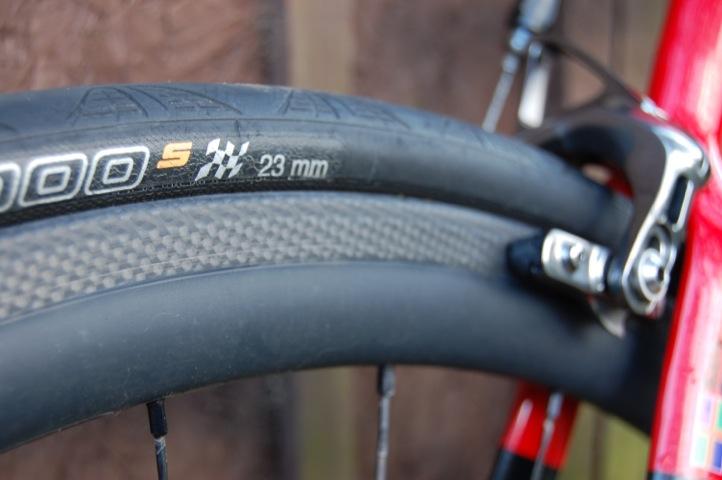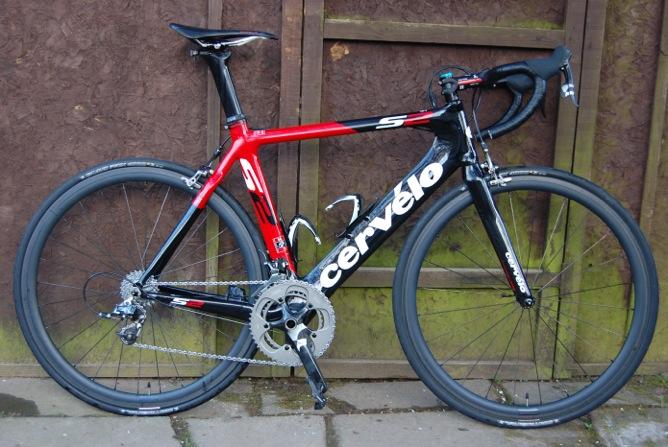- News
- Reviews
- Bikes
- Accessories
- Accessories - misc
- Computer mounts
- Bags
- Bar ends
- Bike bags & cases
- Bottle cages
- Bottles
- Cameras
- Car racks
- Child seats
- Computers
- Glasses
- GPS units
- Helmets
- Lights - front
- Lights - rear
- Lights - sets
- Locks
- Mirrors
- Mudguards
- Racks
- Pumps & CO2 inflators
- Puncture kits
- Reflectives
- Smart watches
- Stands and racks
- Trailers
- Clothing
- Components
- Bar tape & grips
- Bottom brackets
- Brake & gear cables
- Brake & STI levers
- Brake pads & spares
- Brakes
- Cassettes & freewheels
- Chains
- Chainsets & chainrings
- Derailleurs - front
- Derailleurs - rear
- Forks
- Gear levers & shifters
- Groupsets
- Handlebars & extensions
- Headsets
- Hubs
- Inner tubes
- Pedals
- Quick releases & skewers
- Saddles
- Seatposts
- Stems
- Wheels
- Tyres
- Health, fitness and nutrition
- Tools and workshop
- Miscellaneous
- Tubeless valves
- Buyers Guides
- Features
- Forum
- Recommends
- Podcast
OPINION
38mm Far Sports Carbon Wheels: Update #1
 SS-38mm wheel detail
SS-38mm wheel detailI've ridden these wheels for about a couple of months now, from dry sunny days to atrocious 70mile club rides in the driving rain, even a hundred-miler. The first time they went on the bike transformed the way the bike looked, that's not to say there's anything wrong with the shallow profile wheels I had on previously, but the increase in rim depth looks correct on an aero frame. I borrowed my wife's hairdryer one evening (I have little use for one on my own head!) and de-stickered the wheels before putting them on the bike.
With some trepidation, I installed the skinny titanium skewers that arrived with the wheels, there's not much material on them and every ride still has me performing a cursory check to see that everything is all as it should be. So far there's been no problems, despite my concerns about their slenderness.
First impressions
I don't know what I was expecting of the change from aluminium to carbon, which is the primary reason for looking into these wheels in the first place. I had thought that they'd feel different to aluminium wheels, and they're certainly taught and stiff in a way that aluminium isn't, but there's no extra 3mph; the variations are small. The wheels are harder from a comfort perspective, there's less resonance and 'spring' from these wheels compared to my aluminium rims; it's like riding a carbon and aluminium frame, they're both stiff but in different ways. On a fast ride, this is welcome as the wheels feel encouragingly solid, which is letting me to lean into corners with confidence; the bike tracks exactly where I want it.
The weight of the wheels is noticeable, they're not super light at 1,350g, but they are light enough to make the difference on steep climbs where every extra gram on the bike seems to drag you backwards. Out-of-the-saddle efforts and sprints haven't put the wheels under any duress, there's been no uncertainty to the response. Again, this is an area that I thought may have been compromised by such a lightweight wheel, with a rim made from a lightweight material.

Crosswinds
The 38mm deep u-shaped cross-sections cope with crosswinds fairly well. One thing I noted with my bike before was that the frame would catch crosswinds, and the shallow-depth wheels wouldn’t, what this has done is evened out the way the bike behaves and made it more consistent; bike and wheels now move as one when influenced by a side wind. That sounds odd, but it makes handling in such conditions more predictable. A less aero bike may suffer the reverse.
Downsides
There have been a couple of negatives, the first being that the rear wheel has come slightly out of true. Writing this blog reminded me that I need to tend to this issue and a few minutes with a spoke key brought everything back in line. The amount it was out was minimal, and not unlike some other wheels that I've ridden, which have needed a tweak up after a few hundred miles. I was also getting a bit of brake-rub when going up very steep rises, which has now been eliminated.
The second (and main) thing is the braking, it's ok in the dry but leaves a bit to be desired in the wet! The pads I received were Far Sports “ceramic compound” and they have performed very well except on a couple of steep descents in the wet. Scrubbing off initial speed wasn't a problem but they took a long time to start really grabbing despite hauling on the levers with a fair amount of force. A bit of investigation reveals that this isn't something that is specific to these particular wheels, but is more of an issue with all carbon rimmed wheels, worth considering if you plan to replace your current aluminium wheels with carbon alternatives for year round riding.
The rims have suffered slightly from the few really grim rides that they've been subjected to, with a couple of very light scars on he the braking surface. Again, this isn't inconsistent with the wear that I would expect from a light aluminium rim when put in the same situation.
Confidence
Despite the braking not being as sharp as I'd like, I've got an unexpected confidence in these wheels. Buying directly from China has is not without concern, but so far they've performed admirably. The initial anxieties I had about riding carbon wheels have long been forgotten and I have no apprehension riding them on a daily basis. The way I ride isn't affected by the material, potholes/grave/cats eyes are avoided with the same determination whether carbon or aluminium. A few friends have recommended either Reynolds Blue pads or Swiss Stop Yellow pads, so I'm going to give these a go and see if braking can be improved.
In summary: they feel nice and stiff to ride; the carbon material hasn't resulted in a lack of confidence in the wheels; braking isn't as good as aluminium; they make the bike look great.
More Opinion
Latest Comments
- snooks 3 sec ago
That Synapse was a great bike even if the power pyramid was gimmicky. Then Cannonade screwed it up with poor quality lights, cables ,wire and a...
- David9694 1 hour 17 min ago
'This place is a joke' - Your Royal Stoke parking nightmares...
- don simon fbpe 2 hours 30 min ago
I can't work out whether this is a complaint about being pushed down the list or a huzzah for the plucky Brits trying to kick Putin's ass and fight...
- Rendel Harris 3 hours 14 min ago
I can't speak for this company but I know a couple of people who have contacted manufacturers (one through their LBS, one direct) and asked for...
- Rendel Harris 8 hours 19 min ago
I'm afraid that has been a really worrying change over the last few decades: thirty years ago just shouting at a thief to let them know they'd been...
- hawkinspeter 8 hours 50 min ago
I do carry a cheap TPU tube for emergencies, but the Dynaplug is so much quicker and easier than needing to remove wheel/tyre etc. You just get the...
- Rendel Harris 9 hours 29 min ago
March 21st, 1967: birth of Adrian Chiles.
- chrisonabike 10 hours 56 min ago
(This is rather OT now, but...)...
- chrisonabike 11 hours 37 min ago
That's old hand! You really want a hand with integrated display.
- David9694 13 hours 5 min ago
It made a hole and police are looking into it.
Add new comment
39 comments
Sam, I may have missed it in your first blog but what alu wheels did you move from and are comparing these to?
Thanks
Pro-Lite Bracciano.
If you start from the premise that no one buys carbon rims for practical reasons (wet weather braking being the most obvious negative), I do not understand why anyone would buy clinchers over tubs.
I'm inclined to buy a nice wheelset, but I think I'll be opting for an alu braking surface, and clinchers. Unless I was racing, why would I go with tubs? I'm not sure I like the idea of a puncture in the middle of nowhere on a tub.
In reverse order.
A puncture in the middle of nowhere is a pain in the proverbial whether you are on tubs or clinchers. Its marginally more tedious to change a tub than a tube in a clincher - although there's no chance of pinching your tube when you mount a tub - and you do have to be a bit more cautious on the way home cause your spare tub won't be as secure as the one you just took off. But its not that hard. And you never get pinch flats, unlike clinchers.
Why go with tubs? Why not? Maybe try something different and see what all the fuss is about. Why should racers have all the fun? I would recommend that everyone should try tubs, they are great.
(An aside: The problem with tubs is that all the wheel manufacturers have poured money into developing high end aluminium clinchers, so finding a high end aluminium tubular rim is hard work - mostly they are mid range (or you go with carbon, which is another story and not my first choice in miserable weather). Also, forget riding 'cross on clinchers. Try running a clincher at 26psi and see how many pinch flats you get.)
Once you get used to them they really are just another thing you take for granted. Sure its an arse when you do puncture them (so far as I can tell since the sad passing of Peter Burgin there's only one bloke left in the country who repairs tubs, and its £14 a throw). The gluing process is like mowing the lawn or ironing - its takes time but its not so hard and mildly satisfying when you are done. Or use tape and it can be done in about 5 minutes.
My point was simply that if you are going to spend a lot of money on what are inherently impractical wheels (to paraphrase - unless you were racing, why would you go with carbon rims) then it seems to me to be slightly odd to then have an attack of common sense and go with the clincher version.
I'd just add that you can add some latex compound to your tubs, which will seal most punctures. Also, a tub puncture at speed is a lot less hair-raising than with a clincher coming off the rim.
Thanks for the update Sam. Don't suppose you are able to compare their behaviour in crosswinds with a v-shaped mid-section wheel? U-shaped seems to be the way forward, but I don't know whether its just marketing?
Unfortunately I don't have any access to any other carbon wheels; I also wonder about the real world differences between rim sections.
I'd certainly recommend the Reynolds blue pads. I started off with swisstop yellow and there was a marked improvement in both wet and dry braking when I put the Reynolds on..
This may be down to the interaction of Reynolds pads and Reynolds rims, not sure.
Pages